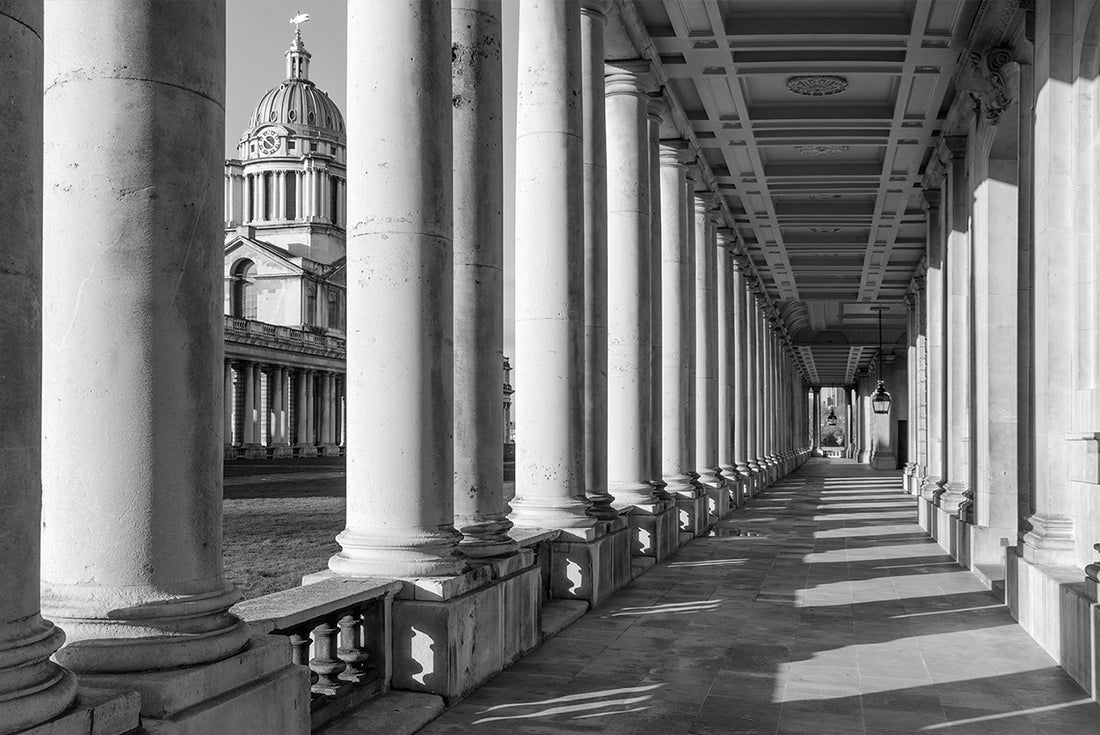
A short history of the Royal Hospital for Seamen in London by Christopher Wren
Share
The Royal Hospital for Seamen (Greenwich Hospital) is Britain’s greatest classical set-piece of the early eighteenth century. Here, Owen Hopkins, Director of the Farrell Centre at Newcastle University and author of our Christopher Wren London Map, explores its history and design...
Greenwich Hospital was established in 1694 by William and Mary as a home for retired sailors – and became Britain’s greatest classical set-piece of the early eighteenth century. But the history of the site goes back much further and played a major role in shaping what Christopher Wren would eventually create.
A royal residence had existed on the banks of the Thames since the Middle Ages, Greenwich being conveniently located along the river from Westminster yet well outside the then city’s boundaries. Under Henry VII, the manor house was upgraded to a palace and was where his son, the infamous Henry VIII, was born (as well as his daughters, the future queens Mary I and Elizabeth I).
In the early 17th century, Anne of Denmark, Queen Consort of James I who had succeeded Elizabeth, commissioned Inigo Jones to create a villa in the park adjacent to the Tudor Palace. Jones had spent time in Italy studying architecture, with particular focus on the works of the 16th-century Mannerist architect, Andrea Palladio. The elegant, if rather austere villa Jones designed was the first authentically classical building to be built in Britain since antiquity. Anne died before the villa was complete, so it was finished Henrietta Maria, consort of Charles I.
After the Commonwealth, Charles I’s son, the restored monarch Charles II, identified Greenwich as the site for a new royal Palace. He commissioned Jones’ pupil, John Webb, to design a new palace in response at least in part to Louis XIV’s palace building exploits, though what Webb envisioned, even if fully realised, would not have come close to the scale or grandeur of Versailles.
In the end, Webb only completed one side of the intended three side composition facing the Thames, with the interiors left unfinished the empty shell boarded up before money ran out and attention moved elsewhere. That was how the site remained for the best part of three decades until Queen Mary II, who succeeded her father James II (Charles II’s brother), after his short and ill-fated reign, with her husband William III, decided to use the site to establish a home for retired sailors, mirroring Chelsea Hospital further up for the river that had recently been built for retired soldiers.

Underlying both projects was, firstly, a desire once again to emulate what was happening in France, in particular Louis XIV’s Les Invalides, a vast, palatial retirement home for soldiers in Paris; and secondly, to find ways to express the monarch’s power architecturally though in a way that also reflected their beneficence. Thus, Greenwich Hospital, or the Royal Hospital for Seamen to give it its proper title, was a palace in all but name.
Wren was the obvious choice as architect: he was surveyor of the King’s Works, the rebuilding of St Paul’s was well underway, the majority of the City churches were complete, and he’d already had experience building in a pseudo-palace typology at Chelsea Hospital, had designed Charles II’s other aborted palace at Winchester, and had recently been engaged by William and Mary to extend and modernise Hampton Court.
Wren’s first instinct was to replicate Webb’s King Charles block to the east (as Webb himself had intended) with a central range linking the two topped by a large dome. Mary, however, objected to this proposal because it would have blocked views from the Queen’s House which she wanted to preserve, having great respect for the villa that had been commissioned by her great grandmother.
Wren’s solution was to have not one but two domes rising either side of a long axis that had the Queen’s House at its terminus. Over subsequent iterations the composition became grander and more Baroque in its handling. Another key move was to replicate the river frontage of King Charles Block to create a wider, yet still symmetrical frontage.
With the overall composition fixed, Wren delegated the design of interior courts between the ranges and frontages facing east and west to his sometime apprentice, protégé and by now established architect in his own right, Nicholas Hawksmoor, who from 1705 served as Deputy Surveyor at Greenwich. Hawksmoor created the austere Queen Anne Court, the idiosyncratic Mannerist King William Court and the robustly Baroque King William Front facing west. The rather less inspiring Queen Mary Court was designed later by Thomas Ripley.
While Hawksmoor certainly played his part at Greenwich and had ambitious and unrealised plans for completing (at least in his view) the composition with a massive central dome on the scale of St Paul’s, the overall authorship remains Wren’s. His genius here as elsewhere was to set the parameters of the design then allowing others to realise it. That said key elements of the design are solely his, most notably the domes with their pairs of columns protruding on the angles on a pedimented base cut through with an arched window, and the twin column colonnade below – all classic Wren moves.
While the view from Greenwich Hospital looking back at Canary Wharf has changed beyond recognition, the one that side of the river back towards Wren’s great composition, with his own Royal Observatory beyond, remains remarkably unchanged and stands lasting testament to the ingenuity of one of Britain’s greatest architects.
Useful information
Royal Hospital for Seamen website
Address: Greenwich Hospital, London, SE10 9JF
Location on Google Maps
Find it on the Christopher Wren London Map
London is shaped by Christopher Wren. From Hampton Court to Greenwich, Wren's works are woven into the physical fabric of London unlike those of any other architect. A selection of Wren’s churches and known works are featured on this two-sided map, with captions and an introduction written by Owen Hopkins and original photography by Nigel Green.

